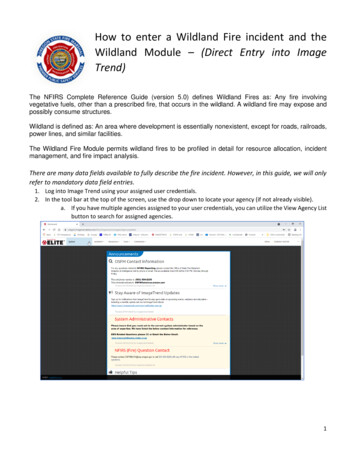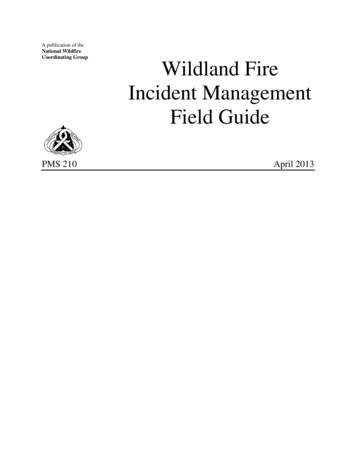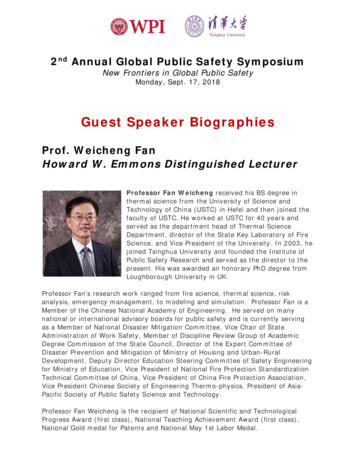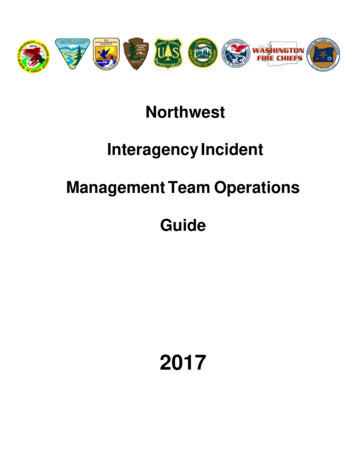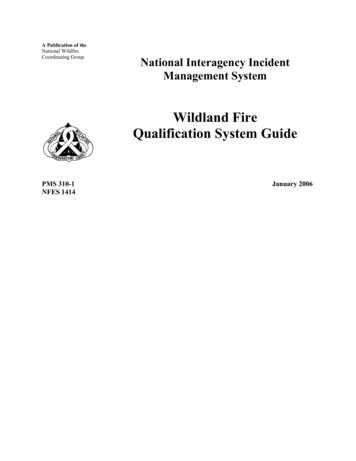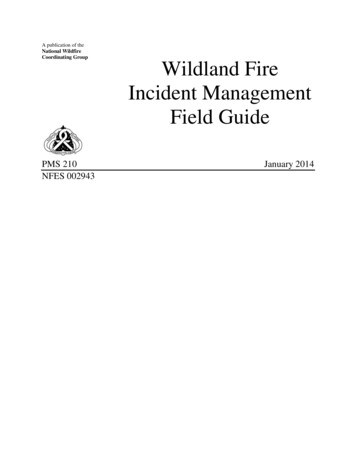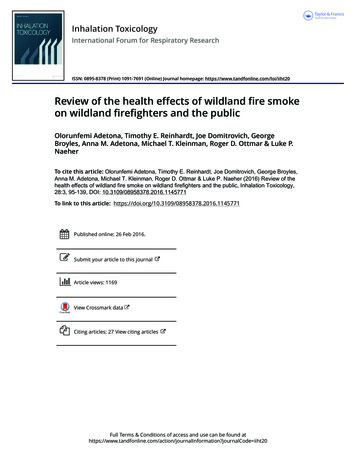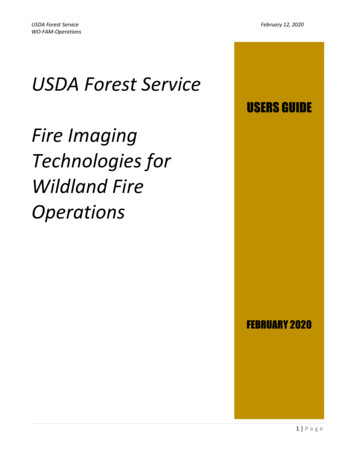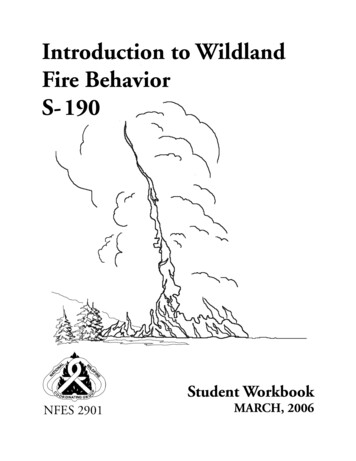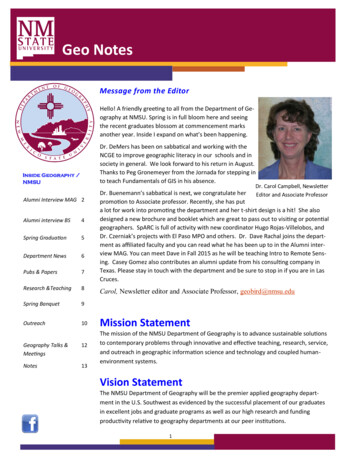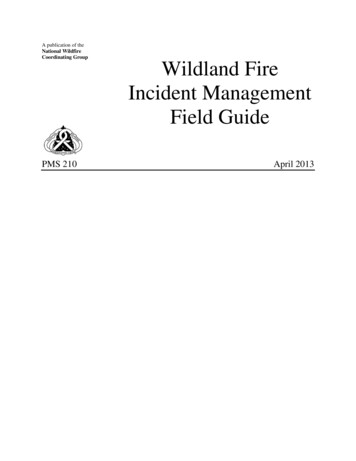
Transcription
A publication of theNational WildfireCoordinating GroupWildland FireIncident ManagementField GuidePMS 210April 2013
Wildland Fire IncidentManagement Field GuideApril 2013PMS 210Sponsored for NWCG publication by the NWCG Operations and Workforce DevelopmentCommittee. Comments regarding the content of this product should be directed to the Operationsand Workforce Development Committee, contact and other information about this committee islocated on the NWCG Web site at http://www.nwcg.gov. Questions and comments may also beemailed to BLM FA NWCG Products@blm.gov.This product is available electronically from the NWCG Web site at http://www.nwcg.gov.Previous editions: this product replaces PMS 410-1, Fireline Handbook, NWCG Handbook 3,March 2004.The National Wildfire Coordinating Group (NWCG) has approved the contents of this productfor the guidance of its member agencies and is not responsible for the interpretation or use of thisinformation by anyone else.NWCG’s intent is to specifically identify all copyrighted content used in NWCG products. Allother NWCG information is in the public domain. Use of public domain information, includingcopying, is permitted. Use of NWCG information within another document is permitted, ifNWCG information is accurately credited to the NWCG. The NWCG logo may not be usedexcept on NWCG-authorized information. “National Wildfire Coordinating Group,” “NWCG,”and the NWCG logo are trademarks of the National Wildfire Coordinating Group.The use of trade, firm, or corporation names or trademarks in this product is for the informationand convenience of the reader and does not constitute an endorsement by the National WildfireCoordinating Group or its member agencies of any product or service to the exclusion of othersthat may be suitable.
PREFACEThe Wildland Fire Incident Management Field Guide is a revision of what used to be called theFireline Handbook, PMS 410-1. This guide has been renamed because, over time, the originalpurpose of the Fireline Handbook had been replaced by the Incident Response Pocket Guide,PMS 461. As a result, this new guide is aimed at a different audience, and it was felt a new namewas in order.P urpose0BThe Wildland Fire Incident Management Field Guide states, references, or supplements wildlandfire incident management and operational standards established by the National WildfireCoordinating Group (NWCG).R elationship to the Incident Response Pocket Guide andEmergency Responder Field Operations Guide1BThis field guide contains some information that is duplicated in the Incident Response PocketGuide (IRPG) and the Department of Homeland Security, Federal Emergency ManagementAgency (FEMA), National Incident Management System Emergency Responder Field OperatingGuide (ERFOG), but the documents have different purposes and user groups. This field guide isthe standard NWCG incident management reference guide. The IRPG is the “wildland fire jobaid and training reference for operational personnel from Firefighter Type 2 through DivisionSupervisor and Initial Attack/Extended Attack Incident Commander,” and is primarily an initialresponder’s tool. The ERFOG “provides guidance designed to assist emergency responsepersonnel in the use of the National Incident Management System (NIMS) Incident CommandSystem (ICS) during incident operations” and is primarily a Command and General Staff tool.R evision Process2BThis field guide will be revised every 5 years. To recommend changes to the document, contactyour agency representative on the Operations and Workforce Development Committee (OWDC).Information about this committee is located on the NWCG Web site at http://www.nwcg.gov.The field guide is available electronically and is formatted for printing on standard 8½ x 11-inchpaper.Wildland Fire Incident Management Field Guidei
iiWildland Fire Incident Management Field Guide
TABLE OF CONTENTSPREFACE . i0BPurpose. i1BRelationship to the Incident Response Pocket Guide and Emergency Responder FieldOperations Guide . i2BRevision Process . iTABLE OF CONTENTS . iiiCHAPTER 1 – FIREFIGHTING SAFETY. 1Risk Management . 1Tenets of a High Reliability Organization . 1Wildland Fire Safety Culture . 2Wildland Fire Safety Principles . 3Clothing and Personal Protective Equipment . 3Fatigue – Work and Rest. 4Nutrition and Hydration . 4Driving Limitations . 5Smoke Impairment of Roads: Assessment and Response . 5Carbon Monoxide Poisoning . 7Injury and Fatality Procedures . 9Serious Injury . 9Fatality . 9Burn Injury Procedures . 10Night Operations . 11Personnel Transportation . 11Firing Equipment . 11Chain Saws. 12Incident-Generated Hazmat . 12Media Access Guidelines . 13General Policy. 13Guidelines . 13Safety Responsibilities of Wildland Fire Supervisors . 15General Responsibilities . 15CHAPTER 2 – OPERATIONAL GUIDES . 17Initial Attack . 17Wildland Fire Incident Management Field Guideiii
Definition of Initial Attack. 17Characteristics of an Initial Attack Incident (Type 4 And Type 5 Incidents) . 17Example of Initial Attack Organization (Type 4 Incident) . 18Duties of an Initial Attack Incident Commander . 18Assessing Incident Progress . 20Updating Incident Status . 20Fire Suppression Strategies . 21Initial Attack Safety Checklist . 22Extended Attack . 23Definition of Extended Attack . 23Characteristics of an Extended Attack Incident . 23Example of an Extended Attack Organization. 24Change From an Initial Attack Incident to an Extended Attack Incident . 24Control or Transfer to Type 2 Incident . 26Extended Attack Safety Checklist . 27Large Fire Management Teams . 28Type 2 Organization . 28Type 1 Organization . 28Organization Chart for Type 1 and Type 2 Incidents . 29Area Command . 29Unified Command . 29Transfer of Command . 30Incident Commander Briefing . 30Incident Commander’s Checklist . 31Agency Administrator(s)’ Responsibility for the Transfer of Command and Release ofIncident Management Teams . 31Transfer of Authority . 32Agency Administrator Briefing . 32Release of an Incident Management Team . 33Urban Interface . 34Wildland/Urban Interface “Watch Out” Situations . 34Identification of Reduced-Risk Structures and Communities . 34Structure Triage Guidelines . 35Structure Assessment Checklist (if Time Permits) . 36Structure Protection Guidelines . 38ivWildland Fire Incident Management Field Guide
CHAPTER 3 – POSITION RESPONSIBILITIES . 41Command and General Staff . 41Organization Chart . 41Position Checklists . 42Operations . 46Organization Chart . 46Position Checklists . 47Air Operations . 52Position Checklists . 54Helispot Location and Construction . 62Principles of Retardant Application . 63Planning . 64Organization Chart . 64Position Checklists . 65Planning Process . 77Demobilization. 77Logistics . 78Organization Chart . 78Position Checklists . 79Logistics Guidelines. 87Factors to Consider When Locating and Laying Out an Incident Base or Camp . 89Finance/Administration. 90Organization Chart . 90Position Checklists . 91CHAPTER 4 – REFERENCE . 97Portable Pumps and Hydraulics . 97Formula for Determining Pump Pressure . 97Reminders for Using Portable Pumps and Hose Lays . 98Drafting Guidelines . 98Expected Output of Commonly Used Portable Pumps at Sea Level . 98General Rules for Fireline Hydraulics . 99Friction Loss by Hose Size and Type . 100Pump Pressures for 50-psi Nozzle Pressure. 101Pump Pressures for 50-psi Nozzle Pressure. 102Wildland Fire Incident Management Field Guidev
Pump Pressures for 50-psi Nozzle Pressure (Continued) . 103Foam . 104Foam Use . 104Foam Mixture Rates . 104Foam for Direct Attack . 105Foam for Indirect Attack . 105Foam for Mop Up . 105Foam for Exposure Protection . 105Foam Safety . 106Use of Fireline Explosives . 106Advantages . 106Disadvantages . 106Hazmat Checklist for Incident Base Management. 107Use of Inmate Crews . 108Production Tables . 109Sustained Line Production Rates of 20-Person Crews in Feet per Hour* . 109Sustained Line Production Rates of 20-Person Crews in Feet per Hour* . 109Sustained Line Production Rates of 20-Person Crews in Chains per Hour* . 110Sustained Line Production Rates of 20-Person Crews in Chains per Hour* . 110Line Production Rates for Initial Action by Hand Crews in Chains per Person per Hour . 111Line Production Rates for Initial Action by Engine Crews in Chains per Crew per Hour . 112Fireline Explosives Production Comparisons . 113Dozer Fireline Construction Rates (Single Pass) in Chains per Hour . 114Dozer Fireline Construction Rates (Single Pass) in Chains Per Hour (Continued) . 115Tractor Plow Fireline Production Rates in Chains per Hour . 116Interagency Crew Qualifications and Equipment Standards . 117Minimum Crew Standards for National Mobilization . 117NWCG Engine and Water Tender Typing (Minimum Requirements) . 118Common Additional Needs for Engines and Tenders (Request As Needed) . 119Air Tankers . 120Helicopters . 120Other References . 121Clear-Text Guide . 121Clear-Text Guide (Continued) . 122viWildland Fire Incident Management Field Guide
ICS Map Display Symbols. 123ICS Map Display Symbols (Continued) . 124Conversion Factors for Map Scale . 126Formula for Area and Circumference of a Circle . 126Acreage Determination Factors . 127Conversion Factors . 130Conversion Factors (Continued) . 131Incident Command System Forms . 132Resource Status Card . 133Distances and Formulas for Estimating Fire Size . 134What the Color and Column of Smoke May Mean . 135Fire Suppression Interpretations From Flame Length . 136Incident Complexities . 137ACRONYMS . 142Wildland Fire Incident Management Field Guidevii
This page intentionally left blank.viiiWildland Fire Incident Management Field Guide
CHAPTER 1 – FIREFIGHTING SAFETYFirefighter and public safety is the first priority of the wildland fire management programand must always take precedence over property and resource loss.RISK MANAGEMENTThe wildland fire environment possesses inherent hazards that can result in harm to firefightersengaged in fire operations. Therefore, sound risk management is the foundation for all firemanagement activities. Risk management is defined as the process whereby managementdecisions are made and actions taken concerning the control of hazards and acceptance ofremaining risk. The risks involved with any fire activity must be identified, assessed, andmitigated (or eliminated) when possible and practicable. The remaining risk must be consideredacceptable to everyone involved and be weighed against the potential benefit during themanagement decision of continuing or discontinuing the activity. We practice risk managementto minimize firefighters’ exposure to inherent hazards in fire operations while still accomplishingmanagement objectives.The five-step risk management process is outlined in the IRPG.Step 1 – Establish situation awareness.Step 2 – Identify hazards and benefits and assess the risk.Step 3 – Control, mitigate, or eliminate hazard.Step 4 – Make go/no-go decision based on acceptability of remaining risk.Step 5 – Evaluate effectiveness of hazard controls and continuously reevaluate.TENETS OF A HIGH RELIABILITY ORGANIZATIONWildland firefighting is described as a “high reliability organization” (HRO) in the bookManaging the Unexpected, by Karl Weick and Kathleen Sutcliffe. The term “high reliabilityorganization” came from researchers who studied the operations and culture of organizations thatroutinely operate in high risk environments yet endure less than their fair share of accidents.The tenets of an HRO serve as foundational practices that firefighters at all levels shouldpromote and model. They include: Preoccupation With Failure – Identify and report all close calls, near misses, andunexpected outcomes. They may be symptomatic of a problem with the system and couldlead to a serious accident if several separate small errors coincide. Reluctance to Simplify – Invite skepticism to common practices, question standards andprocedures, and reconcile diverse opinions. Sensitivity to Operations – Be vigilant to the early detection of small errors, especiallyon the fireline. SPEAK UP if you see potential hazards or anything that seemsunexpected. Make continuous adjustments to operations that prevent errors fromaccumulating.Chapter 1 – Firefighting Safety1
Commitment to Resilience – Think ahead and ask “what if” questions. Always considerthe worst-case scenario. Identify seemingly small errors and find solutions to unexpectedproblems. Maintain the capacity for dealing with new or changing circumstances. Deference to Expertise – Allow decisions to be made by those with the most expertise,not necessarily the one with the most experience or highest rank. Promote and cultivatediversity of thought, and express your opinion.WILDLAND FIRE SAFETY CULTUREThe wildland fire safety culture promotes the concept of organizational learning. Firefighters atall levels should view close calls, near-misses, and/or unintended outcomes as an opportunity tocollectively better our understanding of the systematic conditions in which we operate. Byopenly reporting and examining these events, we gain valuable knowledge of previouslyunrecognized risks and conditions that lend themselves to potential risks before a seriousaccident occurs. The tenets of an HRO are predicated on an organizational “safety culture” thatstrives to identify and minimize previously unrecognized risk through collective organizationallearning. The four critical subcomponents of a safety culture outlined in James Reason’sManaging the Risks of Organizational Accidents include:2 Reporting Culture – Firefighters at all levels should report, openly or anonymously, allcritical or near miss incidents through SAFENETs, SAFECOMs, or Activity Logs (ICS214) even if they entail reporting firefighters’ own errors. Supervisors should, as far aspracticable, separate the collection of information and analysis of reports for safetypurposes from any law enforcement investigation or disciplinary proceedings that mayfollow a serious accident. Just Culture – Fire Management should promote an atmosphere of trust where peopleare encouraged to provide essential safety-related information, yet draw a clear linebetween acceptable and unacceptable behavior. Flexible Culture – Firefighters at all levels are encouraged to adapt to changingconditions and are given the latitude to exercise judgment. They should be technicallyproficient in their job but never assume they are prepared for all contingencies. Expectthe unexpected and react accordingly. Learning Culture – Firefighters should seek continuous, collective improvement inwildland fire safety by observing conditions at all levels of the organization that may leadto potential risks. They should report and help create safety mitigations that can preventfuture occurrences.Chapter 1 – Firefighting Safety
WILDLAND FIRE SAFETY PRINCIPLESFollowing a systematic risk management process, along with adherence to common safetyprinciples and the willingness to identify and report potentially hazardous conditions, are theforemost responsibilities of every firefighter, supervisor, and administrator at all operationallevels.Most of the common fire safety principles for wildland fire operations are found in theIncident Response Pocket Guide (IRPG) which should be carried by all operationalfirefighters on the fireline. These safety principles should be understood at all levels ofcommand. They include but are not limited to: Risk Management Process Look Up, Look Down, Look Around Standard Firefighting Orders Watch Out Situations Lookout(s), Communication(s), Escape(s), and Safety Zone(s) (LCES) Safety Zone Guidelines Downhill Line Construction Checklist Communication Responsibilities First Aid GuidelinesCLOTHING AND PERSONAL PROTECTIVE EQUIPMENT All personal protective equipment (PPE) will meet or exceed agency policy. Wear flame-resistant clothing on the fireline and when flying in helicopters. Do not wearclothing, even undergarments, made of synthetic materials, which can burn and melt onyour skin. Roll your sleeves down to the wrist. Flame-resistant clothing should be cleaned or replaced whenever soiled, especially whensoiled with petroleum products. Flame-resistant clothing will be replaced when the fabricis so worn as to reduce the protection capability of the garment, or is so faded as tosignificantly reduce the desired visibility qualities. Yellow long-sleeved aramid shirts arerequired for national mobilization. Wear a hard hat and leather gloves while on the fireline. Personnel assigned to wildland fires must wear a minimum of 8-inch-high, laced-typeexterior work boots, with
The Wildland Fire Incident Management Field Guide is a revision of what used to be called the Fireline Handbook, PMS 410-1. This guide has been renamed because, over time, the original purpose of the Fireline Handbook had been replaced by the Incident Response Pocket Guide,

